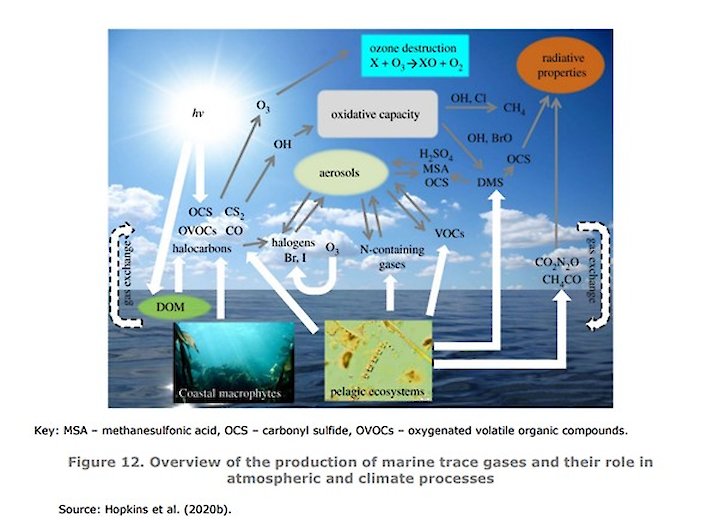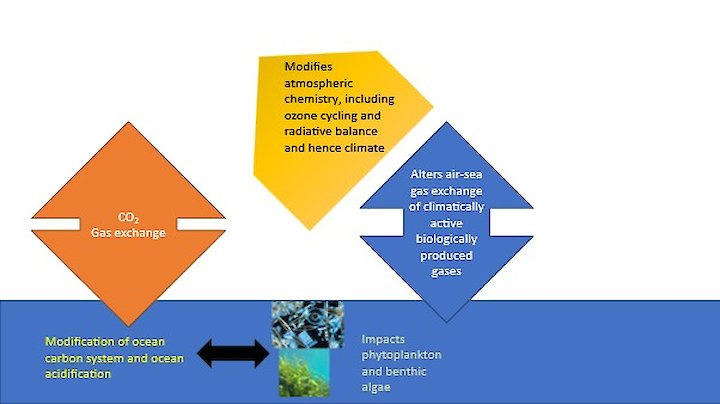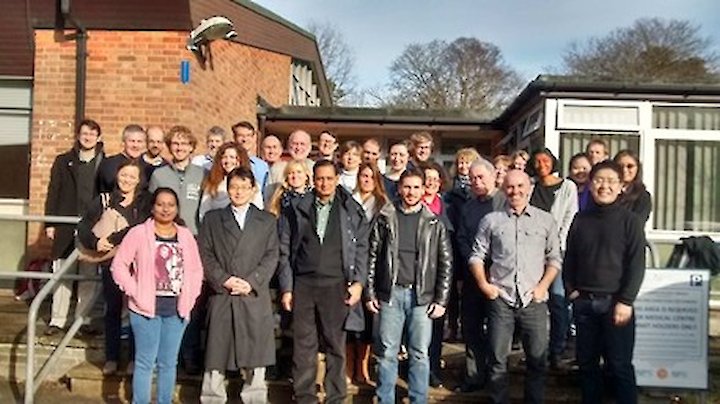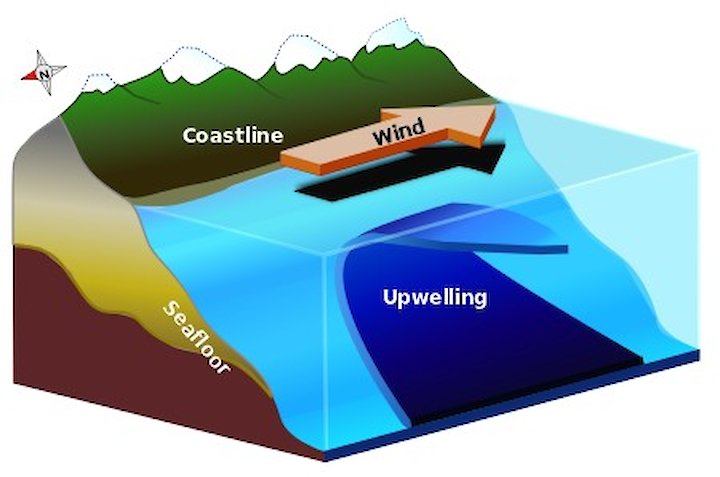Background
Ocean Acidification (OA) is the reduction in the pH of sea water due to the increase in carbon dioxide (CO2) in the Earth's atmosphere. It affects oceans across the globe. Atmospheric carbon dioxide has been increasing since the industrial revolution due to human activities such as fossil fuel combustion and the reduction of forested areas. When carbon dioxide enters the ocean from the atmosphere, several chemical reactions occur that result in a higher concentration of hydrogen ions. This makes the seawater more acidic.
Not only does OA have widespread detrimental effects on the marine ecosystem, but it influences the chemical composition of the atmosphere via air-sea exchanges known as fluxes.
Possible simplified figure caption “simplified representation of the linkage between ocean acidification, the biological production of important gases and atmospheric chemistry.
WG 38’s work has been in response to the following issues:
· The acidity of atmospheric aerosols will change in the future due to changes in the balance of emissions of acid and alkali precursors in the atmosphere.
· Ocean pH will also change due to anthropogenic carbon dioxide emissions. (Tim – I agree that it likely will decrease, but also agree that “change” is probably best)
Workshops and report
From 27 February to 2 March 2017, WG 38 held two linked workshops focusing on the impacts of these changes on air-sea exchange and the wider Earth system. The outputs from these workshops were synthesized in GESAMP Reports and Studies 109 “The changing acidity of the global atmosphere and ocean and its impact on air/sea chemical exchange”. Six papers were also published, and these are listed at the end of this webpage (numbers 13 through 16, 19, and 20).
Please find WG 38’s updated Terms of Reference on pages 8 and 9 of this report.
Photograph of workshop participants
Main findings - workshop on the impact of ocean acidification on fluxes of atmospheric non-CO2 climate-active species
The Earth’s climate and atmospheric chemistry are affected by amounts of trace gases in the atmosphere. Exchanges of these gases between the atmosphere and ocean (known as flux) change due to natural regulation by biogeochemical and photochemical processes in the ocean. However, these oceanic processes are often sensitive to changes in ocean pH (or pCO2) that accompany OA. Therefore, not only is atmospheric carbon deposition increasing OA and affecting the marine ecosystem, but it has potential for further downstream consequences to the climate by altering atmospheric levels of non-CO2 climate-active species.
WG 38 concluded that OA does indeed impact marine sources of key trace gases important for the climate, including:
· Dimethyl sulfide (DMS) - the available information for DMS is considerably greater than for other trace gases.
· Nitrous oxide (N2O)
· Ammonia
· Halocarbons
This conclusion is based on current understanding from observational, experimental and modelling studies. In some experiments, ocean acidification increased trace gas production rates, in others, production rates decreased, in yet others, there was little change. This makes it difficult to make straightforward statements about likely global-scale consequences of OA, therefore further study is critical.
Regions particularly sensitive to OA are polar oceans and upwelling systems, where deep water is brought to the surface by wind.
Upwelling occurs when wind pushes surface water away and deeper water rises to replace it bringing nutrients to the surface and increasing productivity. Image CC Public Domain 1.0. Taken from oppvelling – Store norske leksikon
Recommendations for future work
WG 38 concluded that OA will not operate alone in coming decades, and the combined effect of multiple climate stressors (for example, ocean warming and ocean deoxygenation) on trace gas fluxes must also be considered.
WG 38 recommends that future ocean observations of trace gases should be routinely accompanied by measurements of components of the carbonate system that buffers the acidity of the water. This will improve current understanding of how in situ carbonate chemistry influences gas production.
Together, this will help improve current ability to model these processes and lead to more reliable predictions of future fluxes in global marine trace gases.
Main findings – workshop on changing atmospheric nutrient solubility
As a result of human activity, emissions of nitrogen and sulfur oxides and ammonia have altered the pH of aerosols, cloud water and precipitation. This has caused significant acidification over much of the marine atmosphere.
Some of these emissions have increased the atmospheric burden of reactive nitrogen as well as its deposition to the ocean ecosystems. More information about WG 38’s work on atmospheric nitrogen deposition can be found here [hyperlink to 1st sub-webpage].
Changes in acidity in the atmosphere also have indirect effects on the supply of bioavailable nutrients to the ocean. For nitrogen, these changes in nutrient supply are caused by shifts in the relative amounts of both oxidized (NO3- and HNO3) and reduced (NO3 and NH4+) forms of nitrogen in the environment. This results in different partitioning between gas and particle phases of nitrogen species, which then affects transport of nitrogen species because the different components deposit to the ocean at very different rates.
Other important nutrients, notably iron and phosphorus, are impacted because they become more soluble when exposed to low pH environments during atmospheric transport. These changes affect the magnitude, distribution and deposition of nutrient supply to the ocean.
The ratios of nitrogen, phosphorus, iron and other trace metals in atmospheric deposition are also affected by increased atmospheric acidity. In addition to overall changes in marine productivity, changes in atmospheric acidity, and the resultant atmospheric nutrient supply, also cause shifts in ecosystem composition because marine microbial populations are sensitive to nutrient supply ratio.
While ammonia emissions are much harder to control, nitrogen and sulphur oxide emissions are decreasing in many regions thanks to effective controls. Therefore, the acidity of the atmosphere is expected to decrease in the future, with implications for nutrient supply to the ocean.
With encouragement from WMO, several members of WG 38 also contributed to a paper (number 17 in list below) looking at future strategies for making cost effective measurements of atmospheric parameters over the oceans using ships of opportunity.
Please find a full list of peer-reviewed publications of GESAMP Working Group 38 here.



